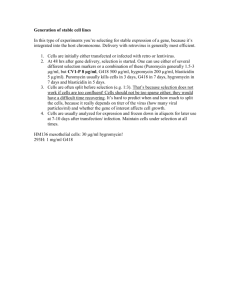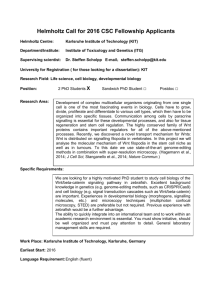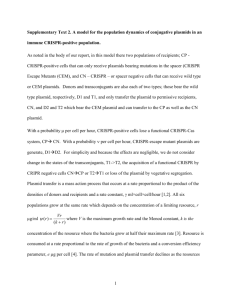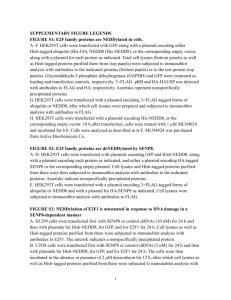SUPPLEMENTARY MATERIALS Supplementary Results A
advertisement
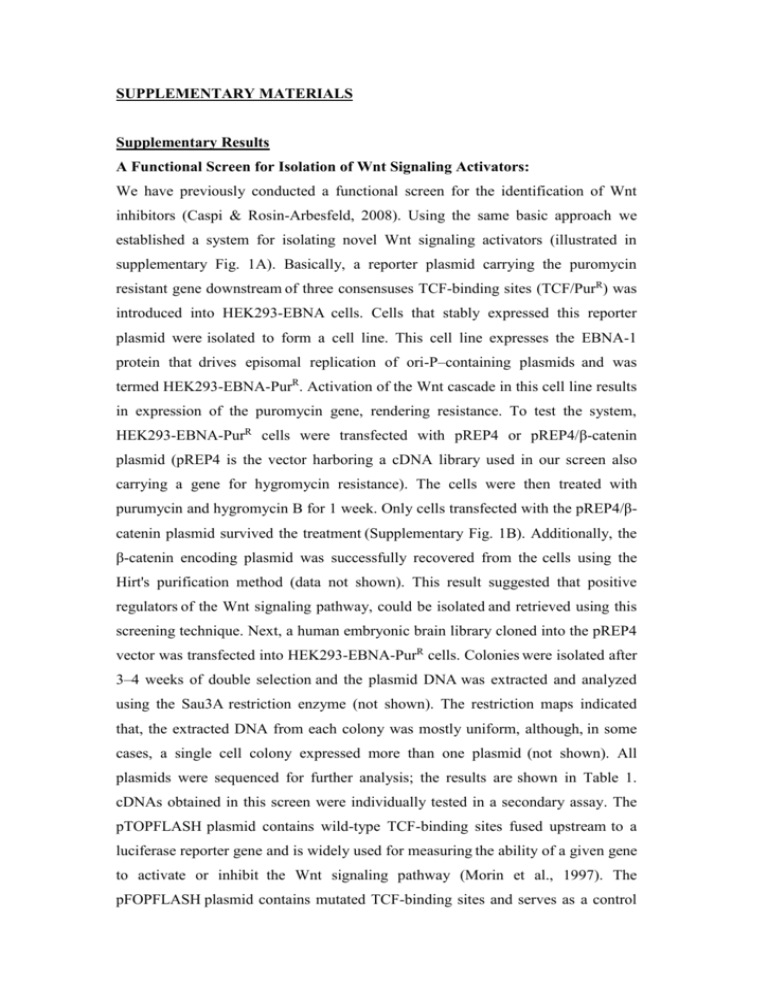
SUPPLEMENTARY MATERIALS Supplementary Results A Functional Screen for Isolation of Wnt Signaling Activators: We have previously conducted a functional screen for the identification of Wnt inhibitors (Caspi & Rosin-Arbesfeld, 2008). Using the same basic approach we established a system for isolating novel Wnt signaling activators (illustrated in supplementary Fig. 1A). Basically, a reporter plasmid carrying the puromycin resistant gene downstream of three consensuses TCF-binding sites (TCF/PurR) was introduced into HEK293-EBNA cells. Cells that stably expressed this reporter plasmid were isolated to form a cell line. This cell line expresses the EBNA-1 protein that drives episomal replication of ori-P–containing plasmids and was termed HEK293-EBNA-PurR. Activation of the Wnt cascade in this cell line results in expression of the puromycin gene, rendering resistance. To test the system, HEK293-EBNA-PurR cells were transfected with pREP4 or pREP4/β-catenin plasmid (pREP4 is the vector harboring a cDNA library used in our screen also carrying a gene for hygromycin resistance). The cells were then treated with purumycin and hygromycin B for 1 week. Only cells transfected with the pREP4/βcatenin plasmid survived the treatment (Supplementary Fig. 1B). Additionally, the β-catenin encoding plasmid was successfully recovered from the cells using the Hirt's purification method (data not shown). This result suggested that positive regulators of the Wnt signaling pathway, could be isolated and retrieved using this screening technique. Next, a human embryonic brain library cloned into the pREP4 vector was transfected into HEK293-EBNA-PurR cells. Colonies were isolated after 3–4 weeks of double selection and the plasmid DNA was extracted and analyzed using the Sau3A restriction enzyme (not shown). The restriction maps indicated that, the extracted DNA from each colony was mostly uniform, although, in some cases, a single cell colony expressed more than one plasmid (not shown). All plasmids were sequenced for further analysis; the results are shown in Table 1. cDNAs obtained in this screen were individually tested in a secondary assay. The pTOPFLASH plasmid contains wild-type TCF-binding sites fused upstream to a luciferase reporter gene and is widely used for measuring the ability of a given gene to activate or inhibit the Wnt signaling pathway (Morin et al., 1997). The pFOPFLASH plasmid contains mutated TCF-binding sites and serves as a control for Wnt signal specificity. Therefore, this assay was used as a secondary screen to test the isolated cDNAs for their ability to specifically activate the Wnt signaling pathway. HEK293 cells were co-transfected with the pTOPFLASH or pFOPFLASH reporters and each individually isolated cDNA plasmid obtained in the first screen. Β-gal was used as a transfection efficiency control. The cDNA clones that specifically activated the Wnt pathway are shown (Supplementary Fig. 2). To note, the effect of most cDNAs on TCF/β-catenin was relatively modest (≤ 1.5 fold). A number of reasons can be attributed to explain this effect: 1. The cDNAs used in the experiments described in supplementary Fig. 2 were isolated from cells that survived an antibiotic selection in the first screen. These cDNAs are cloned in the episomal pREP4 vector (Invitrogen), a large plasmid (10.3 Kb) with a RSV promoter used for target gene expression that exhibits relatively low levels of expression. In the following experiments we use the pCDNA3.1 vector (Invitrogen) which is a smaller plasmid containing a CMV promoter that leads to higher levels of cDNA expression (Kronman et al 1992). The use of the pREP4 plasmid results in relatively modest effects on the Wnt pathway as compared to the pCDNA3.1. For example pREP4-β-catenin activates the Wnt pathway by approximately 1.5 fold (supplementary Fig. 2) while pCDNA3.1-βcatenin activates the pathway by approximately 4 fold (Fig. 1A). In addition, in our screening assay we used rather low concentration of the reporter plasmids (0.2µg/well). In the following experiments we calibrated the transfections using larger amounts of reporter plasmids (0.5µg/well). 2. Different components of the Wnt cascade activate the pathway to different extents. For example: overexpressed Dvl, a known Wnt positive regulator, leads to lower Wnt activity levels in comparison to Fz1 and Wnt3A (Fig. 1C). To ensure that a given cDNA specifically activated the Wnt pathway each plasmid was tested in at least 3 independent experiments performed in duplicate (using both the TOPFLASH and the FOPFLASH reporters). We thus believe that the results seen in Supplementary Fig. 2 represent actual changes in Wnt signaling levels. 3. The library used in our screen was an oligodT library. Although cDNA size fractionation was performed, part of the cDNAs lacked the N-terminus. Thus, in some cases the activity of a specific cDNA may have been impaired (or absent). Supplementary Figure Legends Supplementary Figure 1: (A) Illustration of the basic screening strategy. This screen is based on activation of TCF target gene transcription by triggering the Wnt signal. HEK293-EBNA cells were transfected with the TCF/PurR construct that express the puromycin resistance gene under the control of TCF-binding site. A stable cell line HEK293-EBNA-PurR was obtained. When a library member that activates Wnt signaling is expressed, the puromycin resistance gene is expressed and cells survive in the presence of puromycin. (B) As proof of principle HEK293EBNA-PurR cells were transfected with an empty vector (pREP4) or a β-catenin expression vector (pREP4/β-catenin). The cells were subjected to the same conditions as the library-transfected plates, described in C, but instead of DNA extraction, the cells were fixed subjected to Giemsa staining. (C) An episomal embryonic human brain oligo dT cDNA library containing 2 x 107 independent inserts (purchased from Invitrogen) was transfected into HEK293-EBNA-PurR cells. Forty-eight hours later, the cells were divided into 15 pools and were exposed to puromycin and hygromycin B (the last is expressed on the pREP4 plasmid). Four weeks later, surviving cell colonies were isolated and scaled up. Plasmid DNA was extracted from confluent plates using the Hirt's method. Supplementary Table 1: Summary of the 104 genes identified in the screen. The number of repeats indicates the times a specific gene was isolated independently from different cell colonies. Supplementary Figure 2: The pTOPFLASH or pFOPFLASH plasmids were cotransfected with individually isolated cDNA plasmids into HEK293-EBNA-PurR cells. Out of the 104 cDNAs isolated from the library, 32 cDNAs increased the Wnt signal to different extents. This experiment was repeated three times in duplicates. Supplementary Methods Functional pREP4/cDNA Library Screening An oligo dT cDNA expression library made from embryonic human brain RNA was size selected and the 1.2-5.0-kb fractions were inserted into the episomal pREP4 vector containing an EBV-ori-P and EBNA-1 gene (Invitrogen). The cDNA expression library used for the screen contained 2 x 107 independent inserts. The cDNA expression library was transfected into HEK293-EBNA-PurR cells at ten times the number of independent clones expressed in the library, a complexity that maximized the potential representation of the library genes. HEK293-EBNATCF/PurR cells seeded at 3 x 106 cells per 10 cm plate were transfected with 10 μg of the library DNA using JetPEI (PolyPlus Transfection). Twenty-four hours posttransfection, cells were subdivided into 15 pools and plated on 10 cm plates in fresh DMEM growth media. Twenty-four hours later, the growth media was replaced with puromycin conditioned media (1 μg/ml). Two weeks later, 150 μg/ml hygromycin B was added to the puromycin conditioned growth media and three weeks later, cDNA plasmids were recovered from surviving colonies using the Hirt’s method as describe below. Giemsa Staining HEK293-EBNA-TCF/PurR cells (60% to 70% cells confluent, 3 x 105 cells/well) were transfected in 6-well dishes with 1 μg/well of the pREP4/β-catenin or empty pREP4 plasmids. Following double selection with 1 μg/ml puromycin and 150 μg/ml hygromycin B, growing medium was discarded and wells were washed twice with PBS. Cell colonies were fixed in 100% cold methanol (-20oC) for 15 min, followed by additional two washes with PBS and staining with 10% Giemsa for 15 min. Hirt’s Method HEK293-EBNA-TCF/PurR colonies that survived the double selection (puromycin/hygromycin B) were trypsinized and centrifuged at 500 x g for 5 min at 4°C. The pellets were then suspended in 10 mM Tris-hydrochloride (pH 7.5)/10 mM EDTA and supplemented with 100 µg/ml RNase. Cells were heated at 65ºC for 15 min, and lysed in 1% sodium dodecyl sulfate at 65ºC for additional 20 min. The lysates were supplemented with 1 M NaCl solution and cooled overnight at 4°C. The samples were then centrifuged at 14,000 x g for 30 min at 4°C, and subjected to phenol/chloroform extraction. After performing EtOH precipitation the pellets were collected and dried at room temperature. The candidate DNA was then transformed into E.coli for further analysis.


